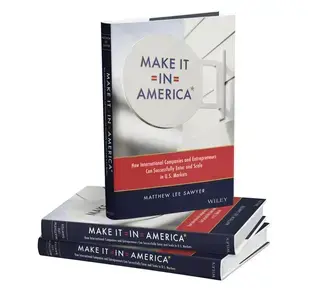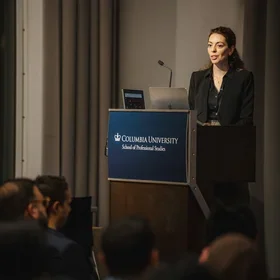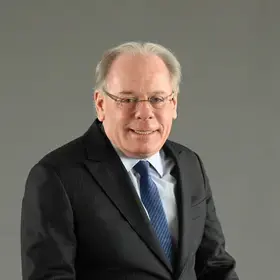In December, Wiley will publish Matthew Sawyer’s book Make It in America—How International Companies and Entrepreneurs Can Successfully Enter and Scale in U.S. Markets. Sawyer is a managing partner at Rocket Market Development LLC and has been a lecturer in the Columbia M.S. in Strategic Communication program since 2014. He developed and teaches the Industry Insider course and advises students in the Practicum course, drawing upon his more than twenty-five years of experience in senior management roles at organizations ranging from early-stage start-ups to Fortune 500 companies.
In his new book, Sawyer interviews 130 business leaders in forty countries to produce a strategic roadmap to doing business—and thriving—in the U.S. market. Student writer Anindita Saraswati Dwiwinata spoke with Sawyer about the origins of the book and what he hopes readers will get out of it. Excerpts follow.

Please tell us briefly about this book and whom it aims to help.
It’s a how-to guidebook for anyone wanting to pursue their American dream in business. It provides insights, tools, and practical advice on a wide range of topics from financing and marketing to protecting intellectual property, working with Americans, and navigating the visa and immigration system. At the end of each chapter, there is a case study of a business that came to the U.S. from a country such as South Korea, India, or Germany. While the book was written for international businesspeople and foreign-born entrepreneurs, it is also useful for Americans who work with international businesses.
Why did you decide to write this book?
I first recognized the need for this book in 2016 when I was helping a French company gain traction in the United States. They struggled because they didn’t understand U.S. market dynamics and business practices. By providing insights into the U.S. competitive environment and customers’ purchase behavior, we were able to help them win several new customers and secure major investment funds.
In addition to consulting and teaching, I mentor people at a business-growth “accelerator,” which nurtures early-stage companies and helps international companies enter U.S. markets. Their foreign businesspeople and entrepreneurs struggled with marketing, sales, funding, legal issues, and managing U.S. employees. They wished there was a guidebook that would explain the intricacies and potential obstacles of doing business in the United States.
Then in 2018, I did a consulting project for the European-American Chamber of Commerce, which is a collective representing more than 25,000 companies engaged in bilateral trade. Several of the Chamber’s leaders encouraged me to write a book that would help foreign companies be better informed and prepared for their journey.
How did your teaching at Columbia contribute to the development of this book?
I approached writing this book in a similar way to how I developed the Industry Insider course for Columbia. It started with setting clear and measurable learning objectives, which guided the selection of topics, case studies, readings, and assignments. Based on the needs and wants from a questionnaire sent to 300 people internationally, I determined that the book would enable readers to become familiar with U.S. business activities, requirements, and players; understand how American culture, business relationships, and marketing activities are unique and require different strategies and management skills; recognize the basic concepts of U.S. legal, tax, and immigration systems; and identify and assess the capabilities needed to succeed in U.S. markets. With these learning objectives in mind, I selected which topics to cover and what tools and recommendations to present. Then I interviewed—using Zoom since it was during the pandemic—130 business leaders and experts. Of course, I also uncovered a lot of information and facts from studying books, articles, and research reports. After five months of research, I started to actually write the book.
How does the book relate to teaching the subject of strategic communication?
The book presents and explains business practices in the United States—in other words, the rules of the game. It also provides insights and an understanding of American culture and regional differences. Plus it provides a glossary of more than fifty business and legal words and phrases. Isn’t that the essence of communication? To better understand your audiences, the way they speak, and the world they live in, so you can connect with them and have a meaningful and productive dialogue. In some cases, you would like to find a common ground, so you are communicating from the same side. In other cases, you would like to persuade them to buy your product, service, or offer.
Can you share what you delivered at the Financial Times’s Live Summit?
In October, I was interviewed by Brooke Masters, U.S. investment and industry editor at the Financial Times at FT Live’s Investing in America Summit. The focus was on a case study in the book about an Australian technology company, Rokt, that successfully entered and scaled in the United States. I arranged for Rokt CEO Bruce Buchanan to also be onstage with us. It was an interesting case where the company relocated to the United States in 2014—two years after being founded in Australia. It grew rapidly, and it is now valued at $1.9 billion.


